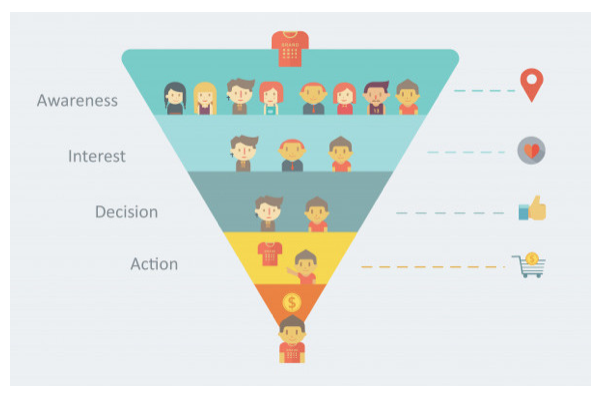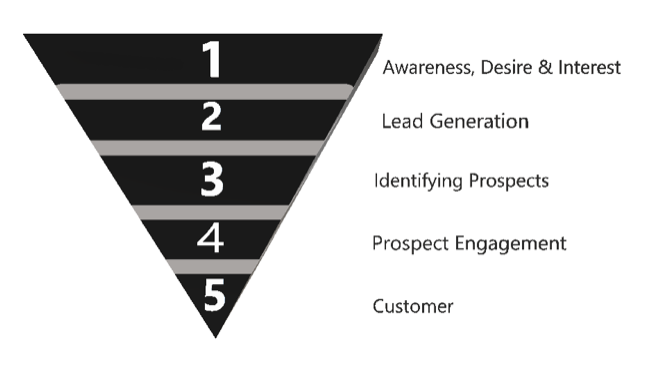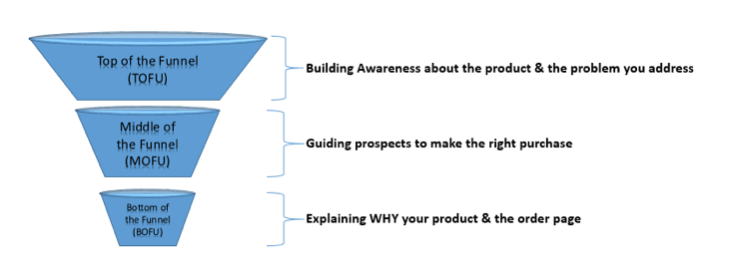Building a Sales Funnel from Scratch: 7 Techniques that Work
Introduction:
Quick Links
Three best friends Nick, Samantha, and Gennaro graduated from a top B-school and embarked on their entrepreneurial journey, hoping to make it big in this world. 3 years later, they’ve all hit a dead end.
- Nick took his successful car accessories business online but couldn’t drive revenue
- Samantha is stuck with cold selling prospects and a poor conversion rate
- Gennaro is struggling to increase revenue after his business flatlined
As I, at EntrepreneursHQ, heard their stories, I realized that all 3 of them were making the same mistake.
Guess what?
They didn’t have a sales funnel!
In this post, we will talk about:
- What is a sales funnel
- The different stages in a sales funnel
- And how can you build one from scratch
Without any further ado, let’s dive in!
What is a Sales Funnel?
A sales funnel is a graphical representation of your customer’s journey from the point of interest to action.
For an online business, it shows you how users move through your website and how they interact with your website at each stage before making their final purchase decision.
E.g. Out of 8 people who visit your website, 3 show interest and add the product to cart, 2 proceed to checkout and 1 ends up making a successful purchase.
This top-down movement with more prospects at the top turning into fewer customers at the bottom in a funnel-shaped manner is a funnel in action.

Stages of a Sales Funnel
By breaking down the funnel into different stages, you can learn the motivations of different prospects and figure out the right content strategies to influence better outcomes for your business.
Let’s look at a simple sales funnel with 3 stages.
- Qualify
A prospect showing enough interest to qualify as a lead.
- Contact
Contacting the lead with discounts, free demos, and other freemium deals to pique prospect interest.
- Convert
Make the final offer to convert the prospect to customer.
A more complex sales funnel could have more stages:

- Awareness, Desire & Interest
- Lead Generation
- Identifying Prospects
- Prospect Engagement
- Customer
But no matter how many stages are there in a sales funnel, it can be broken down to 3 main parts.

1 TOFU (Top of the Funnel)
At this stage, your goal is to generate enough qualified prospects for your sales pipeline.
The beginning of the process is about knowing your audience and qualifying them for product/service match and their sales readiness.
Understanding the interests, expectations, pain points, etc of your audience that will help you pitch the right product or service to your prospect.
2 MOFU (Middle of the Funnel)
At the middle stage, your goal is to nurture your relationship with the prospect.
This comprises offering free helpful content, identifying and documenting the needs of your prospect, and finally presenting examples of your customer success stories, case studies, and testimonials.
3 BOFU (Bottom of the Funnel)
At the bottom of the funnel, your goal is to convert the prospect into a customer.
It starts with sharing your final offer along with pricing details, payment options and details of after-sales support.
The BIG idea is:
A good sales funnel ensures that you offer the right content to the prospect at every stage to drive them down to the next stage of the funnel.
Offer convenience to your prospects while they are making their purchase by enabling SSO options, eliminating unnecessary steps in the purchase process, reducing or removing unwanted forms, etc.
And after the sale, your next goal should be to turn 1 purchase into multiple purchases later by focusing on customer retention.
How to Build a Sales Funnel from Scratch
1 Map your Ideal Buying Process:
The buying process is the series of steps a consumer follows from the beginning to purchase.
The buying process should recognize the need of the consumer, offer adequate information, options to choose from, address and evaluate the consumer questions, create an experience for the customer and ultimately, focus on converting the prospect to a buyer.
2 Plan Ideal Content Delivery:
Ensure that the content is delivered to the consumer in the right manner at all stages of the funnel.
To nurture the lead that has entered your system, offer targeted content for unique buyer personas, personalized emails and content based engagement programs.
Let your content be the guide for the prospects!
3 Track, Test and Analyze your Funnel:
There is no perfect sales funnel.
At every stage of the funnel, you need constant optimization to achieve the desired results. To do so, prepare yourself with the right set of tools to track everything happening during a buyer’s journey. Analyze the data collected and test your funnel to identify leaks.
This is perhaps the most important aspect while building a sales funnel and hence, we will tell you more about how you can optimize a sales funnel in the next section.
7 Techniques to Optimize Your Sales Funnel:
1 Segment your sales funnel to analyze it:
Instead of aggregating the whole information into one broad category, divide the data using a variety of filters. Slice and dice the data to have meaningful insights on all levels. The most accepted methods are:
Horizontal Segmentation:
Segment the data horizontally using the user level information to identify the number of visits at each step in the funnel and the percentage of visits that did not continue to the next step.
Vertical Segmentation:
Slice the data vertically based on the marketing channels you have in play. This will give you insight into performing and non-performing channels. It also shows you the dependency of any channel.
In addition to this, time-based segmentation is a good practice to find the right growth opportunities with the changing trends.
2 Track the full funnel conversion rate:
Track the conversion rate of your sales funnel at each stage. This gives you insights about the abandoned % at each stage of the funnel.
Eg: How many visited the website, how many of them added the product to the cart, how many went through the checkout page and how many placed orders.
These data points will help you to focus the marketing efforts where it matters.
3 Use Google Analytics:
GA is one of the most powerful tools available today to analyze your website’s traffic. It offers features like campaign-traffic measurement, goal tracking, audience reports to know your users, flow visualization reports and even custom analytics reports.
4 Analyze the Landing Page:
Anything that is unrelated to the focus of the landing page should be removed immediately. Check the landing page for every minute detail like:
- Headlines
- Sub-headlines
- Copy
- Color
- Font size
- Background image
- Purchase path
- CTA (if applicable)
- Visual consistency
Tip: Always keep the value propositions above the fold.
5 Test and Analyze all Signup Forms (at all stages):
Signup forms act as an interactive tool for consumers. Test all the elements of the order forms at all the stages of the funnel. Depending on the type of business, the elements can be:
- Title
- Text Box Placement
- Text Box Wording
- Number of Text Boxes per Page
- Readability of Captcha
6 Trust, Reliability and Credibility:
Trust elements on a website play a major role in driving traffic towards or away from your website, and helps increase conversions.
Therefore, a well thought placement of all trust elements at each stage is essential.
Some of the common trust elements you can consider having on your website are:
i Business Logo
ii Service or Product Guarantee
iii SSL certificate
A normal SSL certificate is fine in most cases but as your business grows, you should consider getting Extended Validation (EV) SSL that mentions your Trade Name, Legal Name and Country in the browser.

iv Multiple Testimonials from Past Customers
v A Terms of Use, Privacy Policy and Cookie Policy as per GDPR guidelines
vi VeriSign Logo, if applicable
7 Monitoring Email Conversions:
As a part of your marketing strategy, you will be touching the consumers with your content via emails. Keep a close eye on the factors listed below to correlate your marketing efforts to a hard number.
- Subject Line and Email Copy
- Email Open rates
- Click Through rate
- Conversion rate
- Email Bounce rate
- Unsubscriber rate
- Spam complaints
- Forwarding rate
Conclusion:
Most of the time, the very first funnel you build may not make you profitable. In fact, the goal of your first funnel is to acquire customers and to breakeven.
As you get better at this, you will come across several new strategies and techniques to filter more people through your business.
You have made it to the end. By “end”, I really mean the beginning. Now that you’ve gone through the concept and the recipe, you’re ready to build your own sales funnel.
For understanding more about the marketing funnels of proven entrepreneurs, do head over to Entrepreneurs HQ.
Good Luck!
Author Bio
Liam Austin is the founder of Entrepreneurs HQ. He is a Life-long entrepreneur, focusing on business development, strategy, content and anything else. A former professional soccer player, addicted to podcasts, surfing and burritos. Previous experience growing media companies in Australia and the UK Know more about Liam
How to Use AI-Powered SEO Tools for WordPress eCommerce
SEO is a critical factor in the success of any e-commerce WordPress store. As competition…
0 Comments11 Minutes
Why Short-Form Videos Are the Future of Content Marketing
Your Instagram customers spend over 50% of their time watching short-form videos and reels. Rather…
0 Comments12 Minutes
The Role of Digital Marketing in Business Growth
Online marketing touches every aspect of a business, whether it is initiating the idea or for an…
0 Comments3 Minutes
AI Meets Authenticity: Balancing Automation and Human Touch in Content Marketing
Is your brand starting to sound like a robot? In a world where algorithms write faster than any…
0 Comments8 Minutes
Essential Tools for Enhancing Web Design and UX Hosting
Have you ever visited a website that felt slow, clunky, or confusing? A website that is poorly…
0 Comments11 Minutes
How a Mini Cart Transformed My Store’s Shopping Experience
Okay, real talk—running an online store is hard. You think you’ve got everything figured out, you…
0 Comments9 Minutes
Balancing Your Security Initiatives With Industry Compliance Requirements
Managing a business today comes with a number of daily battles that need to be fought. Resources…
0 Comments11 Minutes
Best plugins to enhance the customer shopping experience
Customer experience is a key part of every online store. A good experience helps customers find…
0 Comments7 Minutes









Comments are closed.